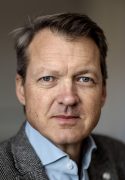FINANCES. Premises, staff, travel, equipment. Prices are rising, but compensation to the University is not keeping up. The surplus in capital that many organizations have will come in handy in the next few years, accodring to Peter Tellberg, the University’s chief financial officer. He is optimistic about the University of Gothenburg’s ability to deal with inflation.
“I envision that we will pay much higher prices than the levels for which we are compensated, but at the same time the University of Gothenburg is rich and in a good position to face the future. However, the surplus in capital carried forward from previous years is linked with specific departments and projects, so the potential looks different in different organizations,” says Tellberg.
Some inertia
Inflation in Sweden has reached the highest level in many years. Ten percent inflation means that everything has become ten percent more expensive, but in many areas inertia delays the increase in costs for the University.

“For example, the framework agreements signed for various services and goods continue. The price level will not be adjusted until a new procurement is held. In other areas, such as travel, we already are noting price increases.”
Since the University of Gothenburg spends about SEK 100 million a year on travel, a 10 percent rise represents a substantial increase in costs.
Moreover, inflation affects procurements that need to be initiated, such as the purchase of expensive instruments and other heavy equipment. The price can be particularly high if the purchase needs to be made from the United States, because the U.S. dollar has also appreciated by about 20 percent compared to the Swedish krona since the beginning of the year. The uncertain world market also means that delivery times for ordered equipment may be longer than usual.
Staff and premises
The University’s biggest expense is staff salaries. Central negotiations this spring will establish the framework for RALS negotiations in the autumn 2023, which affect wages within the Swedish government.
“Employee parties probably will want to see higher wage increases, but it is impossible to say how much higher. Since it is so difficult to assess how things will evolve, I think we will reach an contract that runs for just one year, instead of three years as is usually the case,” says Tellberg.
Premises are also a major expense, with expenditures likely to already increase substantially next year. October’s inflation–or the Consumer Price Index (CPI), formal measure of inflation–determines rent increases for the coming year. For October 2022, the CPI is estimated to range between 12 and 15 percent, which would be the rent increase for next year in that case. This means inflation will probably cost the University as a whole about SEK 70 million extra in premises costs next year, not including the rental costs for the newly built Natrium building.
“Sahlgrenska Academy rents a lot of square meters, and at faculty level, we estimate that the rent increase will be about SEK 13 million next year,” says Tellberg.
Money in the bank
There is a large capital surplus brought forward from previous years within the University, with part of the funds belonging to organizations within Sahlgrenska Academy. This capital surpluse is actually delayed projects and recruitments, so the funds are clearly linked to individual departments and projects.
In August 2022, Sahlgrenska Academy had a capital surplus of more than SEK 620 million. Several of the departments have a buffer. However, Kristina Johansson, financial manager at the Faculty Office, notes that only part of these funds are available to mitigate rental costs and other price increases.

“A lot of the capital is funds intended for individual researchers or specific strategic initiatives,” she says. “In addition, some of the funds are linked to researchers’ data collection activities, which are funds not used in projects and that researchers need to be able to use for co-financing and overhead costs not covered by future grants. In other cases, the funds may be earmarked for recruitment that has not yet taken place.”
Big difference among institutes
In other words, a large buffer exists within Sahlgrenska Academy, but it is unevenly distributed. Four institutes (Clinical Sciences, Medicine, Neuroscience and Physiology, and Biomedicine) each have more than SEK 100 million saved in their coffers. Core Facilities is burdened with an old deficit and is now also seeing sharp increases in energy costs that make it difficult to continue pay off the accumulated deficit.
“We also need to anticipate that the planned rebuilding of Experimental Biomedicine (EBM) will be costly, but it should not be postponed. The building is 30 years old and needs to be modernized for several reasons, including an improved working environment and energy efficiency. Since EBM’s activities play a key role for much research at the University, we hope to discuss opportunities for funding from all levels of the University to cover increased costs for the rebuilding of EBM,” says Kristina Johansson.
The Institute of Health and Care Sciences has the smallest buffer, so it faces major challenges when costs increase.
Sahlgrenska Life – rental discussions underway
The Sahlgrenska Life project now stands at the threshold of becoming a real building. Demolition of the arch between the Per Dubbshuset and the old Department of Rheumatology has begun on the Sahlgrenska lot to prepare the site before construction begins. Discussions are also underway between the University of Gothenburg and the landlord in preparation for the rental offer to be presented next month.
“The last official calculation of the rental level was produced just over a year ago, in September 2021. Since then, the consumer price index has increased, which will affect the rental proposal. Exactly how much of an increase in rent this will entail is unclear,” says Jonathan Chausset, the University of Gothenburg’s project manager for Sahlgrenska Life.
During November the proposal for the rent will become clear. It will then be presented to Sahlgrenska Life’s steering committee and the Faculty Board. The presentation will also include other premises costs, such as operating costs for Buildings 2 and 3. The rental proposal is a fixed rent, which will then apply from the date of access to the new premises and for the subsequent 20 years. As with other leases the University has, the rent level will be adjusted annually with the consumer price index.
BY ELIN LINDSTRÖM











